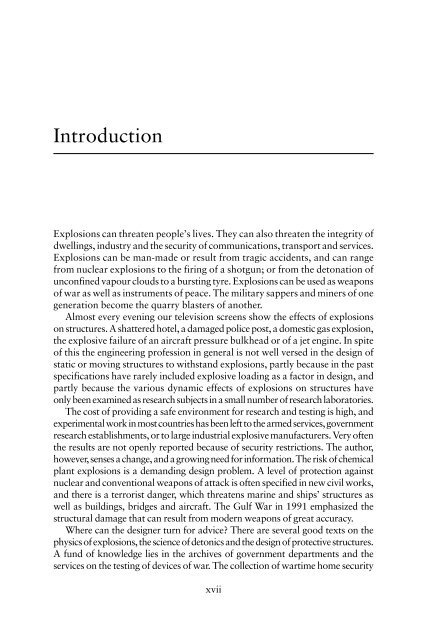A History of Research and a Review of Recent Developments
A History of Research and a Review of Recent Developments
A History of Research and a Review of Recent Developments
You also want an ePaper? Increase the reach of your titles
YUMPU automatically turns print PDFs into web optimized ePapers that Google loves.
Introduction<br />
Explosions can threaten people’s lives. They can also threaten the integrity <strong>of</strong><br />
dwellings, industry <strong>and</strong> the security <strong>of</strong> communications, transport <strong>and</strong> services.<br />
Explosions can be man-made or result from tragic accidents, <strong>and</strong> can range<br />
from nuclear explosions to the firing <strong>of</strong> a shotgun; or from the detonation <strong>of</strong><br />
unconfined vapour clouds to a bursting tyre. Explosions can be used as weapons<br />
<strong>of</strong> war as well as instruments <strong>of</strong> peace. The military sappers <strong>and</strong> miners <strong>of</strong> one<br />
generation become the quarry blasters <strong>of</strong> another.<br />
Almost every evening our television screens show the effects <strong>of</strong> explosions<br />
on structures. A shattered hotel, a damaged police post, a domestic gas explosion,<br />
the explosive failure <strong>of</strong> an aircraft pressure bulkhead or <strong>of</strong> a jet engine. In spite<br />
<strong>of</strong> this the engineering pr<strong>of</strong>ession in general is not well versed in the design <strong>of</strong><br />
static or moving structures to withst<strong>and</strong> explosions, partly because in the past<br />
specifications have rarely included explosive loading as a factor in design, <strong>and</strong><br />
partly because the various dynamic effects <strong>of</strong> explosions on structures have<br />
only been examined as research subjects in a small number <strong>of</strong> research laboratories.<br />
The cost <strong>of</strong> providing a safe environment for research <strong>and</strong> testing is high, <strong>and</strong><br />
experimental work in most countries has been left to the armed services, government<br />
research establishments, or to large industrial explosive manufacturers. Very <strong>of</strong>ten<br />
the results are not openly reported because <strong>of</strong> security restrictions. The author,<br />
however, senses a change, <strong>and</strong> a growing need for information. The risk <strong>of</strong> chemical<br />
plant explosions is a dem<strong>and</strong>ing design problem. A level <strong>of</strong> protection against<br />
nuclear <strong>and</strong> conventional weapons <strong>of</strong> attack is <strong>of</strong>ten specified in new civil works,<br />
<strong>and</strong> there is a terrorist danger, which threatens marine <strong>and</strong> ships’ structures as<br />
well as buildings, bridges <strong>and</strong> aircraft. The Gulf War in 1991 emphasized the<br />
structural damage that can result from modern weapons <strong>of</strong> great accuracy.<br />
Where can the designer turn for advice? There are several good texts on the<br />
physics <strong>of</strong> explosions, the science <strong>of</strong> detonics <strong>and</strong> the design <strong>of</strong> protective structures.<br />
A fund <strong>of</strong> knowledge lies in the archives <strong>of</strong> government departments <strong>and</strong> the<br />
services on the testing <strong>of</strong> devices <strong>of</strong> war. The collection <strong>of</strong> wartime home security<br />
xvii


